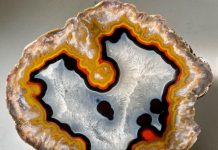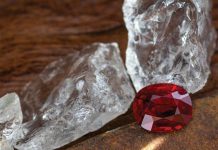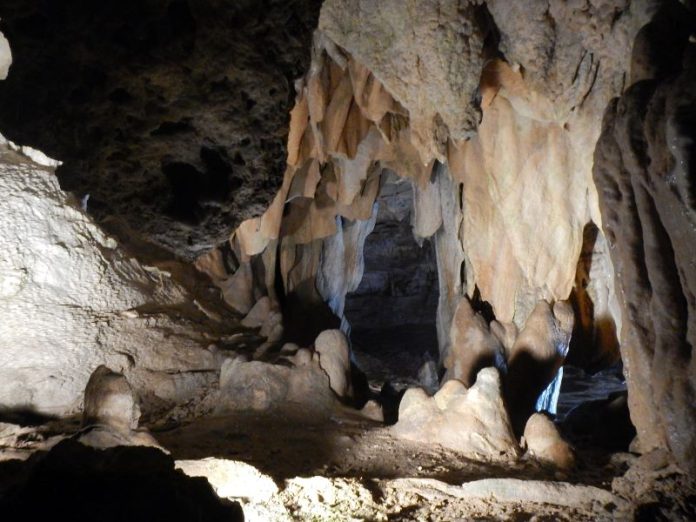
Caving is something that everyone should be able to enjoy. But if you or one of your travel companions has physical limitations, you may avoid caves as part of your travel plans. Fantastic Caverns, the only naturally-formed, completely drive-through cave tour in North America, is located a few minutes northwest of Springfield, Missouri, and provides a viable caving option for all.
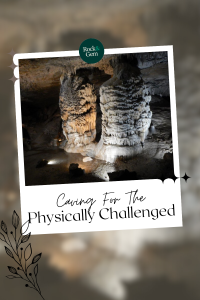
The ‘Whys’ and ‘Hows’ of Ride-Through Caving
‘Physically challenged’ has a variety of meanings. It could mean that you are confined to a wheelchair; a recent injury may have you in a cast or on crutches; you may have had a recent surgery or, you may just be at a stage in your life where you feel unsafe walking on damp, uneven surfaces. A vision or hearing loss may also deter a cave visitor. Another reason for taking a ride-through cave tour may be that you are on a multi-generational outing that includes young children and grandparents, both of whom may have difficulty walking at the pace of a traditional cave tour.
Fantastic Caverns can handle almost any of these situations. They use propane-powered Jeeps to pull large trams through the cave for a 55-minute caving tour. Most visitors just step up onto the tram and grab a bench seat in the wagon. Because of the height of the cave and the width of the tram ramp, wheelchairs are restricted to 45 inches high by 28 inches wide. If your chair doesn’t meet those requirements, but you’re able to transfer into the passenger seat of the Jeep, you may get to ride shotgun with the tour guide. For visitors with hearing loss, English transcripts of the tour are available. At this point, everyone is on the same tour, hearing the tour guide’s explanations and able to ask questions—everyone has the same experience.
Cave Formation
As you near the cave, you’ll notice the green, rolling hillsides. The topography is perfect for the excess rain to collect in crevices and filter underground to the formations below. At some point in the cave’s formation, a large river flowed underground, leaving wide passages, making it perfect for the ride-though experience. Fantastic Caverns is still actively forming. Stalactites and stalagmites are formed during rainy periods, as chemically-charged water droplets glisten from the existing stalactites, soda straws, draperies and other formations on the cave’s ceiling. Fossils can be found throughout the cave including starfish and crinoids. The temperature inside the cave remains a comfortable 600F year-round, the ambient temperature of the area.
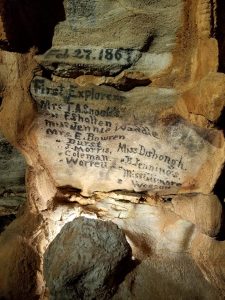
Courtesy Fantastic Caverns
Caving Discovery and Exploration
From the cave’s parking lot, you’ll enter a large covered display area on your way to the visitor center, ticketing and boarding area for the tour. Displays are cleverly interspersed along accessible ramps with stairway shortcuts for more agile visitors. These displays tell much of the cave’s history. This cave was first discovered by Juno, a bloodhound belonging to local farmer John Knox. While out for a walk in 1862, Juno ran after an animal and disappeared. After searching the area, the farmer heard the dog’s faint bark coming from a small hole in the hillside. He returned home for a lantern, then he crawled into the small entrance to find his dog and the cave.
John kept his discovery secret to prevent the exploitation and mining of saltpeter from the cave during the Civil War. Saltpeter found in the cave’s decomposing bat guano could have provided the potassium nitrate needed, when refined, to provide the explosive power in the gunpowder used at that time.
After the war, in 1867, John Knox placed an ad in a Springfield newspaper asking for volunteers to explore the cave. To his surprise, 12 young ladies, belonging to a Springfield women’s athletic club, showed up on his doorstep to accept the challenge. Those young women carved their names into the cave wall where you can still see them today.
A Cave With Many Uses
Over the years, the cave held several names and served many functions from a meeting place for the KKK, a distillery and speakeasy, a concert hall and as host to a live radio show in the 1950s and 60s.
In the 1950s, the cave finally got its current name, Fantastic Caverns. Visitors took traditional walking tours through the cave until the drive-through concept was introduced in 1962. Folks were riding through Fantastic Caverns long before the Americans With Disabilities Act (ADA) was established in the early 1990s.
Electric lighting was introduced in the 1970s and upgraded to LED in 2017. The current owners started working as managers and conservators in 1966 until they purchased the property in 1992. Their commitment to the drive-through concept provides future conservation because visitors never have the opportunity to touch the cave formations, which can cause permanent damage.
Fantastic Caverns: 4872 N. Farm Road 125, Springfield, MO 65803 Phone: 417-833-2010 Website: www.fantasticcaverns.com Tours start at 8 a.m. The last tour is at 4 p.m.
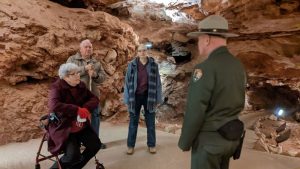
Courtesy NPS
Bucket List Caves for the Physically Challenged…or Not
Following, are a few more outstanding caves at the national parks that are known for their accessibility. Everyone deserves to enjoy the underground beauty of caves!
Carlsbad Caverns National Park, NM
In 2023, Carlsbad Caverns celebrated its centennial anniversary. This national park cave is considered one of North America’s premier caves. There are two cave entrances, the natural entrance with steep winding pathways, and the elevator entrance located inside the visitors’ center which provides ADA access to approximately 1.25 miles of the Big Room trail. Photos don’t do justice to this cavity, nearly 4,000 ft. long by 626 ft. wide and 255 ft. at its highest point. Be sure to request or download an ‘Accessibility Guide’ which details all of the park’s accessible features, including a map of the trail in the Big Room.
Besides the cave, the bat amphitheater is also accessible for folks with limitations and provides a ranger program and viewing point to watch thousands of bats leave the cave each night at dusk from late May through October. National Park Passholders, plus up to three companions, get free self-guided entrance to the cave when they present their pass at the main desk in the visitors’ center. All non-passholders pay $15 per adult, children ages 15 and under are free. www.nps.gov/cave/index.htm
Mammoth Cave National Park, KY
Mammoth Cave is one of the longest and most extensive cave systems in the world. The Park Service offers a special “Accessible Tour” covering a half-mile section of this historical cave with no stairs. This caving tour depends on the operation of the elevator, so park representatives suggest calling before a visit. With a two-week notice, a sign language interpreter can be available for hearing-impaired visitors and an audio guide is also available for the vision impaired. A variety of tours are also available for cavers without disabilities. Although the cave is a National Park, there is no National Park Fee or Pass required. Tour costs vary, however, National Park Pass holders receive half off the cost of any cave tour. Many of the park’s trails are also accessible to individuals with physical limitations. www.nps.gov/maca
Kartchner Caverns State Park, AZ
This cave first opened to the public in 1999. It is located inside a full-service State Park with camping and even a few accessible cabins. From the Discovery Center, a tram takes visitors and their wheelchairs right to the entrance of the cave which is 100% accessible to most wheelchairs and scooters, some walkers, but no crutches are allowed. But because of the width of the paths and steep grades (12%) in some areas, there are some restrictions so please call ahead. There are three caving tours available to book, but no photos or videos are allowed, except on special photography tours that are only available during certain times of the year. Reservations are strongly recommended. www.azstateparks.com/kartchner
Wind Cave National Park, SD
The unique features of this National Park are not only the caves underground, but, also above ground, the park is second only to Yellowstone NP for wildlife viewing on its vast prairie grasslands. Wind Cave contains 95% of the world’s known cave features called ‘boxwork,’ which forms in thin blades creating a box-like pattern. When surrounding bedrock and limestone erode, these calcite veins become visible.
A wide variety of caving tours are available, from the ‘accessibility tour’ for visitors with mobility, vision and hearing issues, to strenuous four-hour tours requiring visitors to have spelunking skills. Caving tours for the hearing impaired that require a sign language interpreter must be reserved a minimum of two weeks in advance. All other tours can be booked online with half of all tours available for booking on the day of your visit, on a first-come, first-serve basis. The ‘accessibility tour’ leaves and returns from an elevator located approximately 200 yards south of the visitor center with accessible parking nearby. www.recreation.gov
National Parks Pass ProgramThe National Parks & Federal Recreation Lands Pass Program offers a lifetime pass to U.S. citizens and permanent residents with disabilities, documentation is needed. Similar passes are available to seniors, military, veterans as well as certain volunteers. Visit NPS Pass Program online for details. |
This story about caving previously appeared in Rock & Gem magazine. Click here to subscribe. Story and photos by Sue Eyre.


